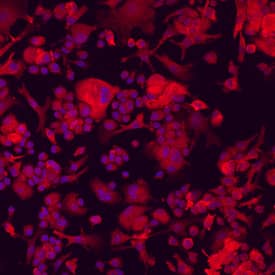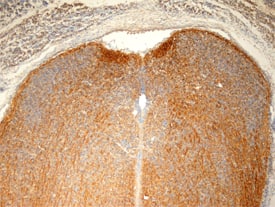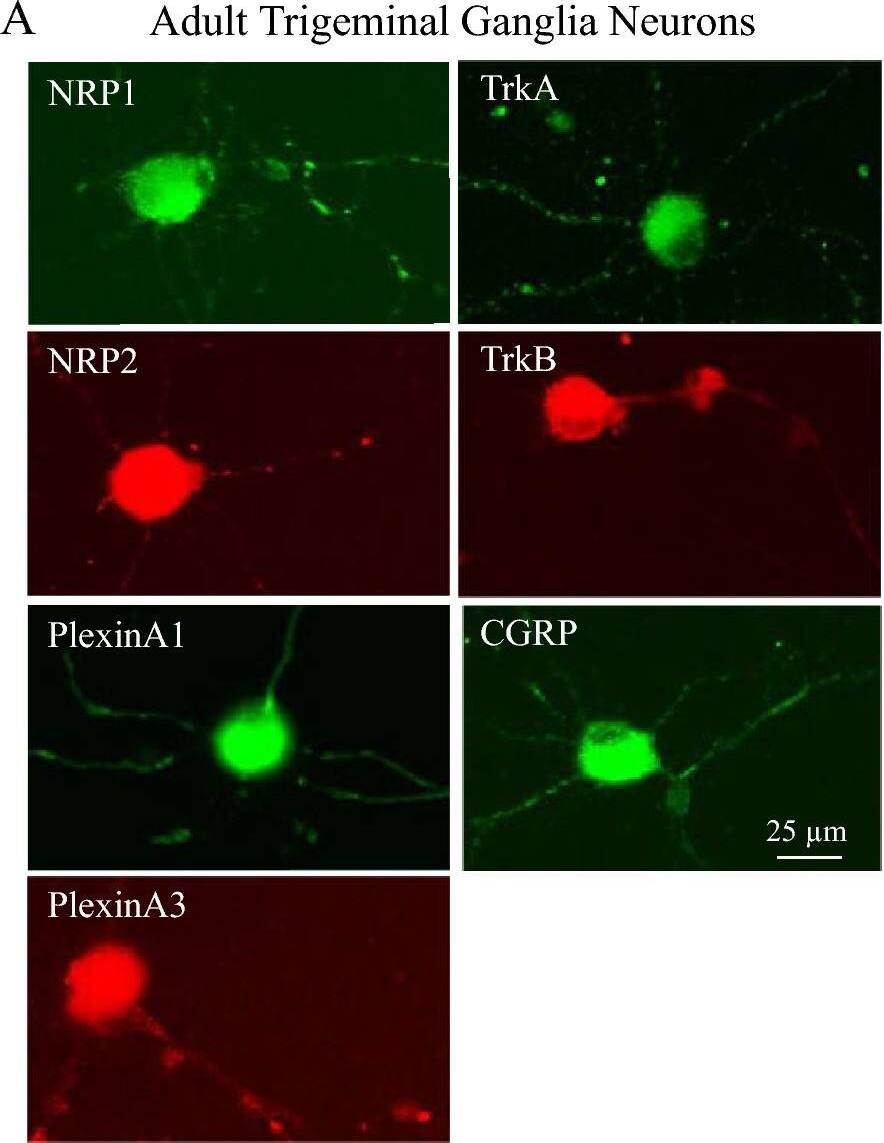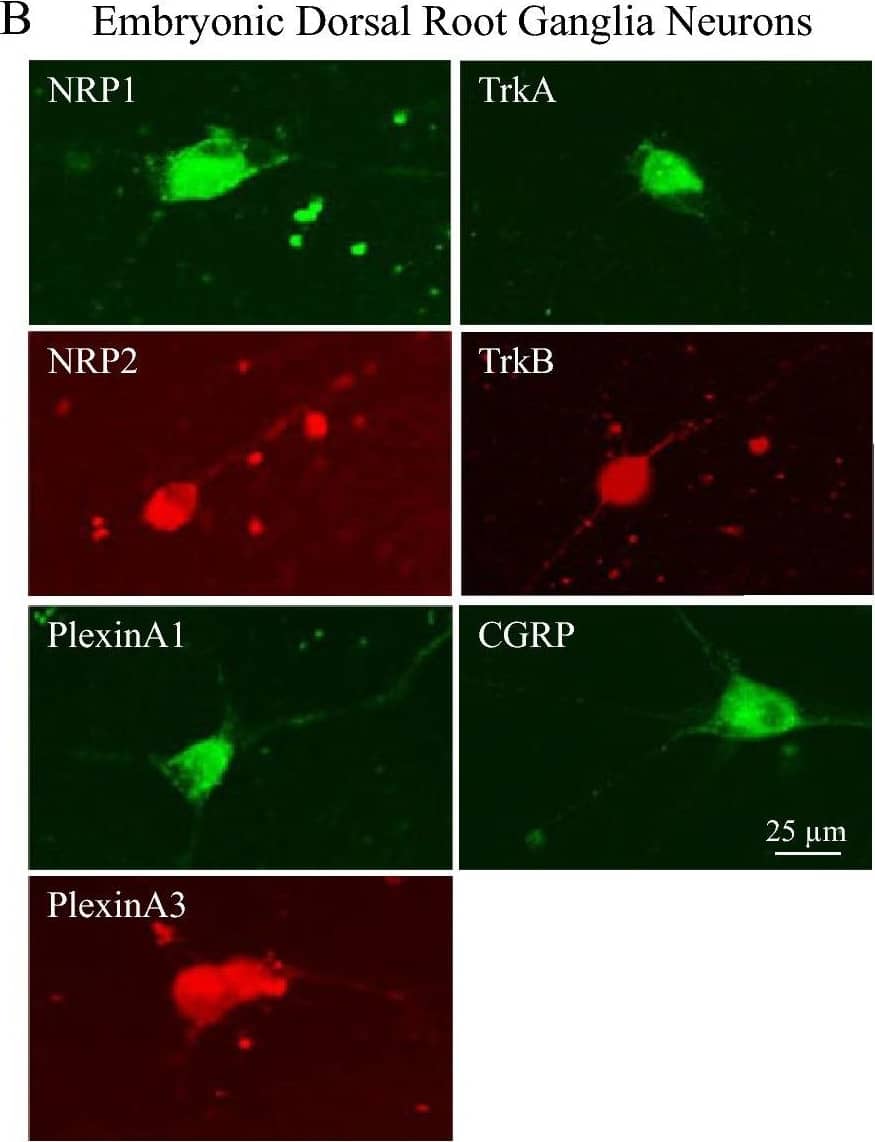Human/Mouse Plexin A1 Antibody
R&D Systems, part of Bio-Techne | Catalog # AF4309

Key Product Details
Species Reactivity
Validated:
Cited:
Applications
Validated:
Cited:
Label
Antibody Source
Product Specifications
Immunogen
Ser28-Pro1242
Accession # P70206
Specificity
Clonality
Host
Isotype
Scientific Data Images for Human/Mouse Plexin A1 Antibody
Detection of Mouse Plexin A1 by Western Blot.
Western blot shows lysates of mouse embryonic heart tissue. PVDF Membrane was probed with 1 µg/mL of Mouse Plexin A1 Antigen Affinity-purified Polyclonal Antibody (Catalog # AF4309) followed by HRP-conjugated Anti-Goat IgG Secondary Antibody (Catalog # HAF019). A specific band was detected for Plexin A1 at approximately 200 kDa (as indicated). This experiment was conducted under reducing conditions and using Immunoblot Buffer Group 8.Plexin A1 in Human Dendritic Cells.
Plexin A1 was detected in immersion fixed immature human dendritic cells using Goat Anti-Mouse Plexin A1 Antigen Affinity-purified Polyclonal Antibody (Catalog # AF4309) at 10 µg/mL for 3 hours at room temperature. Cells were stained using the NorthernLights™ 557-conjugated Anti-Goat IgG Secondary Antibody (red; Catalog # NL001) and counterstained with DAPI (blue). Specific staining was localized to cell surfaces and cytoplasm. View our protocol for Fluorescent ICC Staining of Non-adherent Cells.Plexin A1 in Mouse Spinal Cord.
Plexin A1 was detected in immersion fixed frozen sections of embryonic mouse spinal cord using Mouse Plexin A1 Affinity-purified Polyclonal Antibody (Catalog # AF4309) at 15 µg/mL overnight at 4 °C. Tissue was stained using the Anti-Goat HRP-DAB Cell & Tissue Staining Kit (brown; Catalog # CTS008) and counterstained with hematoxylin (blue). View our protocol for Chromogenic IHC Staining of Frozen Tissue Sections.Applications for Human/Mouse Plexin A1 Antibody
Immunocytochemistry
Sample: Immersion fixed immature human dendritic cells
Immunohistochemistry
Sample: Immersion fixed frozen sections of embryonic mouse spinal cord
Western Blot
Sample: Mouse embryonic heart tissue
Formulation, Preparation, and Storage
Purification
Reconstitution
Formulation
Shipping
Stability & Storage
- 12 months from date of receipt, -20 to -70 °C as supplied.
- 1 month, 2 to 8 °C under sterile conditions after reconstitution.
- 6 months, -20 to -70 °C under sterile conditions after reconstitution.
Background: Plexin A1
Plexin A1 (formerly Plexin 1) is a 200 kDa type I transmembrane protein that is a member of the Plexin family of Semaphorin signal transducers (1). Plexin signaling induces cytoskeletal remodeling, which mediates cell migration and axon repulsion (2). The mouse Plexin A1 cDNA encodes 1894 amino acids (aa) including a 27 aa signal sequence, a 1215 aa extracellular domain (ECD) with one Sema domain, a spacer, and four tandem IPT/TIG domains, a 21 aa transmembrane segment, and a 631 aa cytoplasmic domain (1). Within the ECD, human Plexin A1 shares 95%, 95%, 92%, 80% and 79% aa sequence identity with mouse, rat, bovine, chicken and Xenopus Plexin A1, respectively. The four mouse Plexin A molecules share 59‑67% aa identity with each other. Plexin A1 binds Class 3 (secreted) Semaphorins indirectly via Neuropilin (Npn)-1 and Npn-2, and binds transmembrane Semaphorin 6D directly (3‑5). Sema3A engagement of Plexin A1 and Npn-1 guides proprioceptive and sensory neurons during development, while Sema3B engagement guides floorplate neurons (5‑8). In contrast, T cell Sema6D engagement of dendritic cell Plexin A1 controls actin polymeration, which supports formation of immunological synapses and enhances the function of the dendritic cells (3, 4, 9). Complex formation with DAP12 allows Plexin A1 signaling through TREM family proteins (10, 11). However, the most striking effect of Plexin A1 deletion is on bone homeostasis, where Plexin A1-deficient mice show increased trabecular bone mass due to downregulated osteoclast differentiation (10). Plexin A1 and Sema6D are frequently expressed in malignant pleural mesothelioma, where they promote anchorage-independent growth through complexing with and activating VEGF R2 (12).
References
- Kameyama, T. et al. (1996) Biochem. Biophys. Res. Commun. 226:524.
- Kruger, R.P. et al. (2005) Nat. Rev. Mol. Cell Biol. 6:789.
- Takamatsu, H. et al. (2010) Cell. Mol. Immunol. 7:83.
- O’Connor, B.P. and J.P.Y. Ting (2008) Immunol. Res. 41:217.
- Takahashi, T. et al. (1999) Cell 99:59.
- Yoshida, Y. et al. (2006) Neuron 52:775.
- Toyofuku, T. et al. (2005) Nat. Neurosci. 8:1712.
- Nawabi, H. et al. (2010) Genes Dev. 24:396.
- Eun, S-Y. et al. (2006) J. Immunol. 177:4271.
- Takegahara, N. et al. (2006) Nat. Cell Biol. 8:615.
- Watarai, H. et al. (2008) Proc. Natl. Acad. Sci. USA 105:2993.
- Catalano, A. et al. (2009) Cancer Res. 69:1485.
Alternate Names
Gene Symbol
UniProt
Additional Plexin A1 Products
Product Documents for Human/Mouse Plexin A1 Antibody
Product Specific Notices for Human/Mouse Plexin A1 Antibody
For research use only






